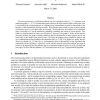Free Online Productivity Tools
i2Speak
i2Symbol
i2OCR
iTex2Img
iWeb2Print
iWeb2Shot
i2Type
iPdf2Split
iPdf2Merge
i2Bopomofo
i2Arabic
i2Style
i2Image
i2PDF
iLatex2Rtf
Sci2ools
115
Voted
CIAC
2006
Springer
2006
Springer
Network Discovery and Verification with Distance Queries
The network discovery (verification) problem asks for a minimum subset Q V of queries in an undirected graph G = (V, E) such that these queries discover all edges and non-edges of the graph. This is motivated by the common approach of combining local measurements in order to obtain maps of the Internet or other dynamically growing networks. In the distance query model, a query at node q returns the distances from q to all other nodes in the graph. We describe how the existence of an individual edge or non-edge in G can be deduced by potentially combining the results of several queries. This leads to a characterization of when a set of queries Q "discovers" the graph G. In the on-line network discovery problem, the graph is initially unknown, and the algorithm has to select queries one by one based only on the results of the previous ones. We study the problem using competitive analysis and give a randomized on-line algorithm with competitive ratio O( n log n) for graphs on...
| Added | 20 Aug 2010 |
| Updated | 20 Aug 2010 |
| Type | Conference |
| Year | 2006 |
| Where | CIAC |
| Authors | Thomas Erlebach, Alexander Hall, Michael Hoffmann 0002, Matús Mihalák |
Comments (0)

